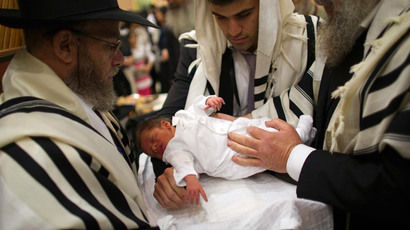Spanish hospital uses stem cells to fix heart attack damage

For the first time in medical history, a hospital in Madrid has successfully treated seven patients who recently suffered heart attacks by using stem cells from donors, according to the hospital’s statement.
“Seven patients have already been operated on and they have progressed very well despite having suffered serious damage to their heart tissue,” the statement, published by Madrid's Gregorio Maranon Hospital, said.
The hospital plans to treat 55 patients in the framework of the ongoing clinical trial which envisages a medical breakthrough in treating heart attacks. According to hospital officials, this is the first time cells coming from a genetically different person, or allogeneic cells, have been used to treat a myocardial infarction.
The injection of the cells is carried out through a coronary artery seven days after the patient has suffered a heart attack, so he is clinically stable and the cardio-repairing will be more effective. The new method limits the damage suffered after a heart episode, activating the regenerative capacity of the heart itself to produce new tissue.
A myocardial infarction, commonly known as a heart attack, occurs when the flow of oxygen-rich blood to a section of heart muscle is blocked. If the heart can’t get oxygen for a sufficient period of time, the section of heart muscle without it begins to die. During recovery from a heart attack, the dead muscle is replaced by scar tissue which does not contract, reducing the heart’s ability to pump blood.

Over the past decades, doctors have been researching methods to regenerate the scarred parts of the heart. The first in-human use of bone marrow stem cells (BMCs) to treat a heart attack was back in 2001. Since then, a large number of clinical studies have demonstrated their benefit.
There are two main types of stem cell transplants which have been used by doctors. The first one is an autologous stem cell transplant, in which the patient receives his or her own stem cells. The second is allogeneic – when stem cells are donated by another person.
The autologous method has been previously used by doctors. However, this method takes four to eight weeks to process a patient's own stem cells to be used in therapy, said the hospital’s head of cardiology, Francisco Ferandez-Avila, in a statement on Friday as quoted by AFP. Meanwhile, donor cells can be processed and stored, so they are available for immediate use, he added.
“Besides this very important advantage, this technique allows for the selection of donors whose cells show the greatest potential to repair” heart tissue, he said. “Before being processed, the allogeneic cells are exhaustively studied and only those that functioned best are selected.”
An estimated 17 million people die of cardiovascular disease, particularly heart attacks and strokes, every year, according to World Health Organization estimates. However, according to researchers, the evolution in clinical practice has substantially reduced mortality caused by heart attacks.














